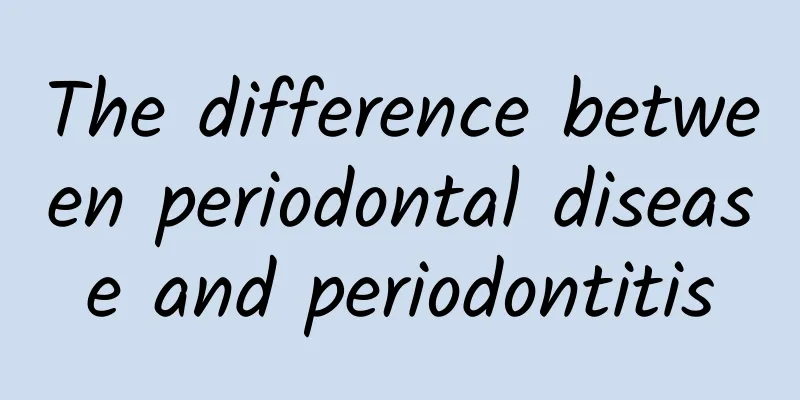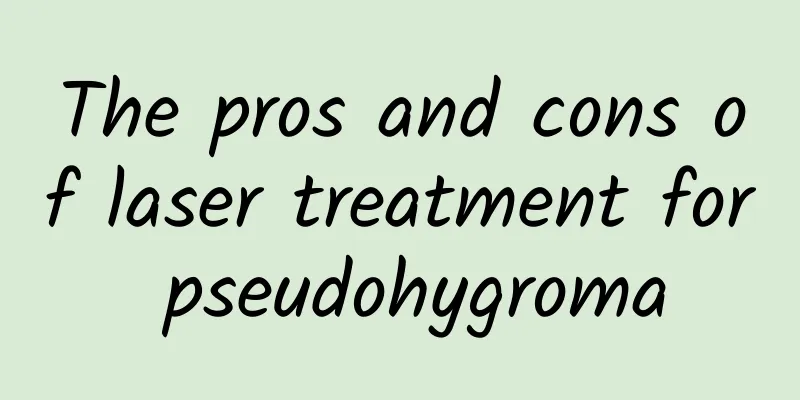The difference between periodontal disease and periodontitis

|
Many people cannot distinguish between periodontal disease and periodontitis. It should be said that periodontal disease has a wider scope. Periodontal disease includes periodontitis, which means that periodontitis is part of periodontal disease. When periodontal disease occurs, it must be treated promptly and well. We should strengthen the prevention and treatment of periodontitis, prevent gingival bleeding, prevent dental tartar, and pay attention to teeth washing and good oral hygiene. 5 key points for preventing and treating periodontitis Keyword 1: Gingival bleeding refers to a small amount of bleeding of the gums caused spontaneously or due to slight stimulation. In mild cases, there will be blood in the saliva only when sucking, brushing teeth, and chewing hard food. In severe cases, the gums will bleed more or even spontaneously when they are slightly stimulated. Generally speaking, chronic inflammation of the gums is a common cause of bleeding gums, so bleeding gums are an early sign of periodontal disease, indicating that you may be at risk of periodontitis. But sometimes it can also be the oral manifestation of certain systemic diseases, and should be given sufficient attention. Keyword 2: Tartar Tartar is the mineralized or mineralizing plaque and soft deposits on the tooth surface. Once formed, it cannot be removed by brushing and needs to be removed by professionals through periodontal cleaning. Dental tartar is an important pathogenic factor in the development of periodontal disease. If you do not pay attention to developing good oral hygiene habits, tartar can easily deposit on the tooth surface again even after thorough cleaning. The mechanical stimulation of these tartar and the dental plaque on the surface of the tartar can further aggravate the inflammation and atrophy of the gums, the absorption of the alveolar bone, and cause gingivitis and periodontitis. Keyword 3: Tooth loss Many people believe that “people will lose their teeth as they get older, this is inevitable”. In fact, there is no inevitable relationship between aging and tooth loss. If there is no periodontal disease, a person will not lose his teeth until he is old. Although it cannot be said that all tooth loss is due to periodontal disease. But in our country, more than half of the teeth leave our body due to periodontal disease. When periodontal disease develops to the late stage, the alveolar bone is absorbed, the tooth roots are exposed, and the teeth fall out. Just like the roots of a big tree, the more part buried in the soil, the more firmly the tree will grow in the land. When soil and water are lost, the forests will also be destroyed. Therefore, tooth loss is a pathological cause rather than a physiological phenomenon. Keyword 4: Tartar that is newly formed after teeth cleaning is mostly yellow in color. After a long time, it will turn into hard black stones. No matter how hard the tartar is, it cannot be removed by brushing like dental plaque and must be removed through specialist treatment. The most scientific way to remove tartar is to clean your teeth, use cleaning instruments to remove tartar, plaque and pigments deposited on the gums, and polish the tooth surface to delay the re-deposition of plaque and tartar. It is recommended to go to the hospital for a check-up every 6 months to 1 year. If there is tartar, cleaning treatment is required. But periodontal disease cannot be cured by simply cleaning your teeth. To cure periodontal disease, systematic treatment of periodontal disease is required. It should also be emphasized that the teeth will experience transient sensitivity after cleaning, and the sensitivity symptoms will disappear in about a week. Keyword 5: Toothpaste Nowadays, many toothpastes and mouthwashes will label their products as "preventing periodontal disease", causing some people to rely too much on using certain brands of toothpaste or mouthwash and neglect the development of oral health habits. In fact, mouthwash and toothpaste do not play a decisive role in dental care. Toothpaste and mouthwash alone cannot clean teeth and interdental spaces well. The correct brushing method is the key, which also includes appropriate brushing time and frequency, the use of dental floss, interdental brushes and other auxiliary brushing methods after meals, etc. When choosing toothpaste, you should also pay attention to the fluoride content. You can choose toothpaste with a fluoride content between 0.05% and 0.15%. Please note that although fluoride has anti-caries function, children sometimes swallow toothpaste. In order to prevent fluoride poisoning, it is not recommended for children to use fluoride toothpaste. |
<<: How to treat periodontitis symptoms
>>: What to do if periodontitis causes severe bad breath
Recommend
Differences Between Senna and Senna Leaves
There is a difference between Senna leaves and se...
Damage to teeth caused by tooth nerve killing
Toothache can sometimes be an unbearable condition...
How to sleep well with sciatica?
Many people have suffered from sciatica in their ...
Causes of hair loss in women over 30
Women in their 30s are also prone to hair loss, a...
Is it okay to use boric acid to wash the vulva?
Using boric acid to clean your vulva is a better ...
Wonderful prescriptions for treating constipation from ancient times to the present
With the development of today's society, the ...
The harmful effects of niacinamide on the skin
More and more people have learned about the white...
Is there a connection between nosebleed and cerebral hemorrhage?
There are many reasons for nose bleeding, the mos...
Can I drink more water if I have kidney deficiency?
Kidney deficiency is a common disease in life. It...
Chicken bone grass lean meat soup
Pork is rich in protein and essential oleic acid,...
Can I smoke if I have erosive gastritis?
Erosive gastritis is a relatively common form of ...
What should be paid attention to during craniotomy for brain trauma
Currently in medicine, the most complex and diffi...
Phlebitis classification and nursing
Phlebitis, also known as thrombophlebitis, mainly...
Medicinal value of Northeast Red Mushroom
What a romantic name, Red Goji Berry. This is pro...
What are the symptoms of head tumors? Six symptoms of head tumor
A head tumor, that is, a tumor in the brain, is a...









